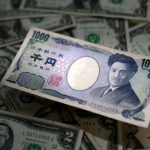
LONDON (Reuters) -The yen stood firm on Monday as the Bank of Japan (BOJ) kicked off a two-day meeting that could be crucial in determining the timing of the end of the central bank’s ultra-loose stance on interest rates.
The recent burst of risk appetite has given the Australian and New Zealand dollars in particular a leg up, with both nudging towards five-month highs on Monday.
The U.S. dollar extended last week’s fall following the Federal Reserve’s signal over the possibility of interest rate cuts next year.
The yen held steady at 142.41 per dollar, after gaining nearly 2% last week.
The Japanese currency has had a volatile few weeks, as markets struggle to get a grip on how soon the BOJ could phase out its negative interest rate policy, with comments from Governor Kazuo Ueda this month initially sparking a huge rally in the yen.
That was later reversed on news that a policy shift was unlikely to come as early as December, and investors now await Tuesday’s BOJ decision for further clarity on the bank’s rate outlook.
In any case, since hitting a multi-decade low against the dollar near 152 in November, the yen has gained around 6% in value as traders have grown increasingly convinced the BOJ’s low-rates drag on the currency will not last much longer.
“This shift in sentiment will no doubt be welcomed by the Bank of Japan and to some extent helps them out with respect to the weakness of the yen ahead of tomorrow’s rate decision,” CMC markets strategist Michael Hewson said.
“There is now less incentive for them to think about altering their current policy settings, although they might hint at starting to execute some form of shift early next year.”
Against the euro, the yen edged down 0.4% to 155.57, but still held near this month’s four-month high of 153.215 per euro.
Highlighting the degree of anticipation around the BOJ meeting was a jump in overnight volatility in the yen to its highest since July.
RISK ON
Elsewhere, the Australian and New Zealand dollars, which can often act as barometers for investor risk appetite in the currency market, traded near their highest in five months.
The Aussie rose 0.35% to $0.6725, not far from last week’s peak of $0.6728, while the kiwi jumped 0.5% to $0.6241.
The prospect of Fed lowering rates early next year kept the mood buoyant across markets. Futures show a roughly 75% chance that the first cut could come as early as March, according to the CME FedWatch tool.
The dollar is now facing its first yearly loss against a basket of major currencies since 2020, as the boost from the Fed’s steep U.S. rate hikes and “higher for longer” messaging has now faded.
The dollar index was last down 0.16% at 102.44, having lost 1.3% last week.
The European Central Bank (ECB) and Bank of England (BoE) likewise kept interest rates steady at their respective policy meetings last week, although unlike the Fed, both pushed back against expectations of imminent rate cuts.
“This divergence is particularly notable given the euro zone’s recent weaker economic performance and more rapid disinflation compared to the U.S. Meanwhile, the (BoE) maintains a cautious stance, showing no indication of deviating from its ‘higher-for-longer’ policy,” said Monica Defend, head of Amundi Investment Institute.
Sterling rose 0.1% to $1.2692, while the euro rose 0.25% to $1.092.
The euro, however, remains hobbled by a gloomy outlook for growth in the euro zone, with data last week showing a downturn in the bloc’s business activity deepened more than expected in December, indicating the economy is likely in recession.
To read the full article, Click Here

